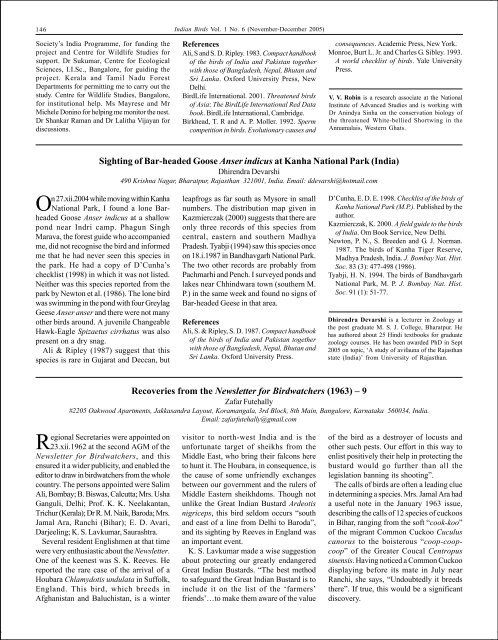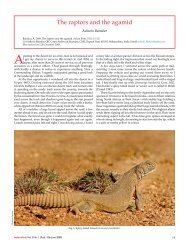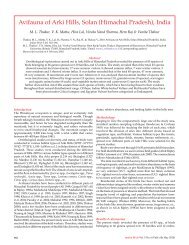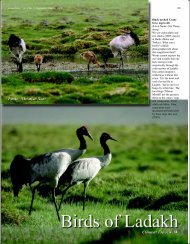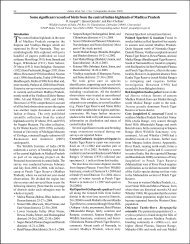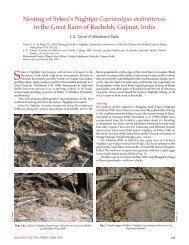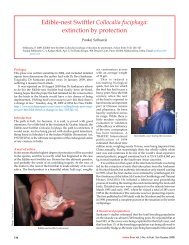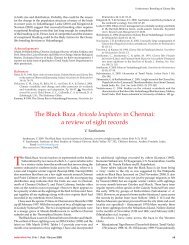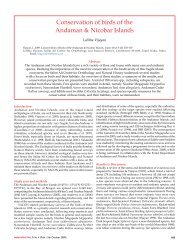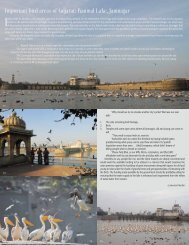Recoveries from the Newsletter for Birdwatchers - Indian Birds
Recoveries from the Newsletter for Birdwatchers - Indian Birds
Recoveries from the Newsletter for Birdwatchers - Indian Birds
Create successful ePaper yourself
Turn your PDF publications into a flip-book with our unique Google optimized e-Paper software.
146<br />
Society’s India Programme, <strong>for</strong> funding <strong>the</strong><br />
project and Centre <strong>for</strong> Wildlife Studies <strong>for</strong><br />
support. Dr Sukumar, Centre <strong>for</strong> Ecological<br />
Sciences, I.I.Sc., Bangalore, <strong>for</strong> guiding <strong>the</strong><br />
project. Kerala and Tamil Nadu Forest<br />
Departments <strong>for</strong> permitting me to carry out <strong>the</strong><br />
study. Centre <strong>for</strong> Wildlife Studies, Bangalore,<br />
<strong>for</strong> institutional help. Ms Mayrese and Mr<br />
Michele Donino <strong>for</strong> helping me monitor <strong>the</strong> nest.<br />
Dr Shankar Raman and Dr Lalitha Vijayan <strong>for</strong><br />
discussions.<br />
<strong>Indian</strong> <strong>Birds</strong> Vol. 1 No. 6 (November-December 2005)<br />
References<br />
Ali, S and S. D. Ripley. 1983. Compact handbook<br />
of <strong>the</strong> birds of India and Pakistan toge<strong>the</strong>r<br />
with those of Bangladesh, Nepal, Bhutan and<br />
Sri Lanka. Ox<strong>for</strong>d University Press, New<br />
Delhi.<br />
BirdLife International. 2001. Threatened birds<br />
of Asia: The BirdLife International Red Data<br />
book. BirdLife International, Cambridge.<br />
Birkhead, T. R and A. P. Moller. 1992. Sperm<br />
competition in birds. Evolutionary causes and<br />
consequences. Academic Press, New York.<br />
Monroe, Burt L. Jr. and Charles G. Sibley. 1993.<br />
A world checklist of birds. Yale University<br />
Press.<br />
V. V. Robin is a research associate at <strong>the</strong> National<br />
Institute of Advanced Studies and is working with<br />
Dr Anindya Sinha on <strong>the</strong> conservation biology of<br />
<strong>the</strong> threatened White-bellied Shortwing in <strong>the</strong><br />
Annamalais, Western Ghats.<br />
Sighting of Bar-headed Goose Anser indicus at Kanha National Park (India)<br />
Dhirendra Devarshi<br />
490 Krishna Nagar, Bharatpur, Rajasthan 321001, India. Email: ddevarshi@hotmail.com<br />
On 27.xii.2004 while moving within Kanha<br />
National Park, I found a lone Barheaded<br />
Goose Anser indicus at a shallow<br />
pond near Indri camp. Phagun Singh<br />
Marava, <strong>the</strong> <strong>for</strong>est guide who accompanied<br />
me, did not recognise <strong>the</strong> bird and in<strong>for</strong>med<br />
me that he had never seen this species in<br />
<strong>the</strong> park. He had a copy of D’Cunha’s<br />
checklist (1998) in which it was not listed.<br />
Nei<strong>the</strong>r was this species reported <strong>from</strong> <strong>the</strong><br />
park by Newton et al. (1986). The lone bird<br />
was swimming in <strong>the</strong> pond with four Greylag<br />
Geese Anser anser and <strong>the</strong>re were not many<br />
o<strong>the</strong>r birds around. A juvenile Changeable<br />
Hawk-Eagle Spizaetus cirrhatus was also<br />
present on a dry snag.<br />
Ali & Ripley (1987) suggest that this<br />
species is rare in Gujarat and Deccan, but<br />
leapfrogs as far south as Mysore in small<br />
numbers. The distribution map given in<br />
Kazmierczak (2000) suggests that <strong>the</strong>re are<br />
only three records of this species <strong>from</strong><br />
central, eastern and sou<strong>the</strong>rn Madhya<br />
Pradesh. Tyabji (1994) saw this species once<br />
on 18.i.1987 in Bandhavgarh National Park.<br />
The two o<strong>the</strong>r records are probably <strong>from</strong><br />
Pachmarhi and Pench. I surveyed ponds and<br />
lakes near Chhindwara town (sou<strong>the</strong>rn M.<br />
P.) in <strong>the</strong> same week and found no signs of<br />
Bar-headed Geese in that area.<br />
References<br />
Ali, S. & Ripley, S. D. 1987. Compact handbook<br />
of <strong>the</strong> birds of India and Pakistan toge<strong>the</strong>r<br />
with those of Bangladesh, Nepal, Bhutan and<br />
Sri Lanka. Ox<strong>for</strong>d University Press.<br />
D’Cunha, E. D. E. 1998. Checklist of <strong>the</strong> birds of<br />
Kanha National Park (M.P.). Published by <strong>the</strong><br />
author.<br />
Kazmierczak, K. 2000. A field guide to <strong>the</strong> birds<br />
of India. Om Book Service, New Delhi.<br />
Newton, P. N., S. Breeden and G. J. Norman.<br />
1987. The birds of Kanha Tiger Reserve,<br />
Madhya Pradesh, India. J. Bombay Nat. Hist.<br />
Soc. 83 (3): 477-498 (1986).<br />
Tyabji, H. N. 1994. The birds of Bandhavgarh<br />
National Park, M. P. J. Bombay Nat. Hist.<br />
Soc. 91 (1): 51-77.<br />
Dhirendra Devarshi is a lecturer in Zoology at<br />
<strong>the</strong> post graduate M. S. J. College, Bharatpur. He<br />
has authored about 25 Hindi textbooks <strong>for</strong> graduate<br />
zoology courses. He has been awarded PhD in Sept<br />
2005 on topic, ‘A study of avifauna of <strong>the</strong> Rajasthan<br />
state (India)’ <strong>from</strong> University of Rajasthan.<br />
<strong>Recoveries</strong> <strong>from</strong> <strong>the</strong> <strong>Newsletter</strong> <strong>for</strong> <strong>Birdwatchers</strong> (1963) – 9<br />
Zafar Futehally<br />
#2205 Oakwood Apartments, Jakkasandra Layout, Koramangala, 3rd Block, 8th Main, Bangalore, Karnataka 560034, India.<br />
Email: zafarfutehally@gmail.com<br />
Regional Secretaries were appointed on<br />
23.xii.1962 at <strong>the</strong> second AGM of <strong>the</strong><br />
<strong>Newsletter</strong> <strong>for</strong> <strong>Birdwatchers</strong>, and this<br />
ensured it a wider publicity, and enabled <strong>the</strong><br />
editor to draw in birdwatchers <strong>from</strong> <strong>the</strong> whole<br />
country. The persons appointed were Salim<br />
Ali, Bombay; B. Biswas, Calcutta; Mrs. Usha<br />
Ganguli, Delhi; Prof. K. K. Neelakantan,<br />
Trichur (Kerala); Dr R. M. Naik, Baroda; Mrs.<br />
Jamal Ara, Ranchi (Bihar); E. D. Avari,<br />
Darjeeling; K. S. Lavkumar, Saurashtra.<br />
Several resident Englishmen at that time<br />
were very enthusiastic about <strong>the</strong> <strong>Newsletter</strong>.<br />
One of <strong>the</strong> keenest was S. K. Reeves. He<br />
reported <strong>the</strong> rare case of <strong>the</strong> arrival of a<br />
Houbara Chlamydotis undulata in Suffolk,<br />
England. This bird, which breeds in<br />
Afghanistan and Baluchistan, is a winter<br />
visitor to north-west India and is <strong>the</strong><br />
un<strong>for</strong>tunate target of sheikhs <strong>from</strong> <strong>the</strong><br />
Middle East, who bring <strong>the</strong>ir falcons here<br />
to hunt it. The Houbara, in consequence, is<br />
<strong>the</strong> cause of some unfriendly exchanges<br />
between our government and <strong>the</strong> rulers of<br />
Middle Eastern sheikhdoms. Though not<br />
unlike <strong>the</strong> Great <strong>Indian</strong> Bustard Ardeotis<br />
nigriceps, this bird seldom occurs “south<br />
and east of a line <strong>from</strong> Delhi to Baroda”,<br />
and its sighting by Reeves in England was<br />
an important event.<br />
K. S. Lavkumar made a wise suggestion<br />
about protecting our greatly endangered<br />
Great <strong>Indian</strong> Bustards. “The best method<br />
to safeguard <strong>the</strong> Great <strong>Indian</strong> Bustard is to<br />
include it on <strong>the</strong> list of <strong>the</strong> ‘farmers’<br />
friends’…to make <strong>the</strong>m aware of <strong>the</strong> value<br />
of <strong>the</strong> bird as a destroyer of locusts and<br />
o<strong>the</strong>r such pests. Our ef<strong>for</strong>t in this way to<br />
enlist positively <strong>the</strong>ir help in protecting <strong>the</strong><br />
bustard would go fur<strong>the</strong>r than all <strong>the</strong><br />
legislation banning its shooting”.<br />
The calls of birds are often a leading clue<br />
in determining a species. Mrs. Jamal Ara had<br />
a useful note in <strong>the</strong> January 1963 issue,<br />
describing <strong>the</strong> calls of 12 species of cuckoos<br />
in Bihar, ranging <strong>from</strong> <strong>the</strong> soft “cook-koo”<br />
of <strong>the</strong> migrant Common Cuckoo Cuculus<br />
canorus to <strong>the</strong> boisterous “coop-coopcoop”<br />
of <strong>the</strong> Greater Coucal Centropus<br />
sinensis. Having noticed a Common Cuckoo<br />
displaying be<strong>for</strong>e its mate in July near<br />
Ranchi, she says, “Undoubtedly it breeds<br />
<strong>the</strong>re”. If true, this would be a significant<br />
discovery.
<strong>Indian</strong> <strong>Birds</strong> Vol. 1 No. 6 (November-December 2005) 147<br />
Peter Jackson’s contributions have<br />
always been of unusual interest, and I quote<br />
<strong>from</strong> his visit to Ladakh, “I reached Leh on<br />
December 15 th . It was a bright sunny morning<br />
with a sprinkling of snow on <strong>the</strong><br />
ground…Magpies Pica pica bactriana<br />
(=Black-billed Magpie P. pica) scavenging<br />
around <strong>the</strong> town were <strong>the</strong> most noticeable<br />
birds…I went by jeep <strong>for</strong> about 140 miles<br />
south-east along <strong>the</strong> Indus. Some 30 miles<br />
<strong>from</strong> Leh <strong>the</strong> valley narrows to a gorge about<br />
50 miles long…(and) <strong>the</strong> gorge finally opens<br />
out into a broad desert plain…The most<br />
common bird was <strong>the</strong> Shore Lark<br />
Eremophila alpestris elwesi (=Horned Lark)<br />
an attractive little lark with black horns,<br />
cheek patches and breast band. With <strong>the</strong>m<br />
were Short-toed Larks Calandrella<br />
acutirostris cinerea (=Hume’s Short-toed<br />
Lark)”.<br />
S. V. Neelakanta kept a careful watch on a<br />
pair of Black Kites Milvus migrans, which<br />
first built <strong>the</strong>ir nest on a banyan tree.<br />
Because of harassment by crows, <strong>the</strong><br />
nesting was never successful. Then <strong>the</strong>y<br />
moved to <strong>the</strong> framework of a water tank and<br />
built <strong>the</strong> nest 40 feet above ground. “The<br />
eggs were laid early in <strong>the</strong> cool wea<strong>the</strong>r, and<br />
<strong>the</strong> two nestlings are already (6 th February)<br />
larger than house crows, and can be seen<br />
exercising <strong>the</strong>ir wings”. Neelakanta<br />
observed later that a pair of House Sparrows<br />
Passer domesticus had become sub-tenants<br />
of <strong>the</strong> kites. “The sparrows are nesting<br />
under and partly within <strong>the</strong> kite’s nest.”<br />
The <strong>Newsletter</strong> became a little more<br />
‘dressy’ when S. V. Neelakanta made a<br />
sketch <strong>for</strong> <strong>the</strong> cover of <strong>the</strong> July 1963 issue<br />
consisting “of Whitebacked Munias<br />
(Lonchura striata) perching on a Casuarina<br />
tree (Casurina equisetifolia). The birds<br />
started building a globular nest on Sunday<br />
<strong>the</strong> 12 th , and finished <strong>the</strong> same on <strong>the</strong> 14 th<br />
May. By kneeling on <strong>the</strong> top of my car, I<br />
was able to put my finger on <strong>the</strong> lateral<br />
entrance of <strong>the</strong> nest on <strong>the</strong> 16 th , and found<br />
no eggs.” In <strong>the</strong> August 1963 issue Mr.<br />
Neelakanta’s article on how birds fly,<br />
illustrated with eight sketches, is well worth<br />
reading if only to understand that <strong>the</strong><br />
general belief that “birds fly by pushing <strong>the</strong><br />
air downwards and backwards with <strong>the</strong>ir<br />
wings” is far <strong>from</strong> <strong>the</strong> truth. Things are not<br />
always, what <strong>the</strong>y seem.<br />
The April 1963 issue carried a fine article<br />
by Jasper Newsome, a nephew of Col. R.<br />
Meinertzhagen (<strong>for</strong>merly renowned <strong>for</strong> his<br />
researches, some of which have now been<br />
proved to be scandalously fabricated).<br />
Writing about birds around Bombay, Jasper<br />
said “For a birdwatcher coming <strong>from</strong><br />
England to step off a boat at Bombay is<br />
twice as exciting as it must be <strong>for</strong> an ordinary<br />
visitor…one entered…a new world full of<br />
wonderful new birds…A morning at <strong>the</strong><br />
National Park was a great success. We saw<br />
an Osprey, some blackwinged stilts, a<br />
greenshank, some common sandpipers,<br />
endless little cormorants, which were new<br />
to me and several species of egret and<br />
heron”.<br />
In March, Jasper went by train to Delhi.<br />
“From <strong>the</strong> com<strong>for</strong>ts of <strong>the</strong> air conditioned<br />
express I looked out at a cross section of<br />
<strong>Indian</strong> countryside. I saw almost 50 species<br />
of birds <strong>from</strong> <strong>the</strong> train, including many new<br />
to me, such as <strong>the</strong> Whitenecked Stork,<br />
Adjutant, Sarus Crane, White Ibis, Peafowl<br />
and o<strong>the</strong>rs…(An) interesting thing about<br />
<strong>the</strong> birds of nor<strong>the</strong>rn India in winter was<br />
that many of <strong>the</strong>m I know in Europe in <strong>the</strong><br />
summer were <strong>the</strong>re <strong>for</strong> <strong>the</strong> winter, and<br />
behaving differently. For example <strong>the</strong> pipits<br />
were hard to identify because <strong>the</strong>y did not<br />
call; similarly <strong>the</strong> Leaf Warblers, Lesser<br />
Whitethroats, and Moustached Warblers<br />
only became obvious when I sat down by<br />
bushes and waited <strong>for</strong> <strong>the</strong>m to emerge or<br />
put up mist-nets and caught <strong>the</strong>m…In May<br />
I go to Kashmir and <strong>the</strong>n to Afghanistan. If<br />
<strong>the</strong> Editor chases me vigorously enough, I<br />
may produce a final article to conclude this<br />
wonderful visit to India and her birds.” Alas,<br />
in Nepal Jasper succumbed to drugs, and<br />
that was <strong>the</strong> end of this splendid young<br />
man.<br />
Joseph George wrote a fascinating piece<br />
on his observations of four species of<br />
young cuckoos. “Young cuckoos of four<br />
different species were seen in New Forest,<br />
Dehra Dun every summer. They were <strong>the</strong><br />
Koel, <strong>the</strong> common Hawk-Cuckoo, <strong>the</strong> Pied<br />
Crested Cuckoo and <strong>the</strong> <strong>Indian</strong> Cuckoo.<br />
Crows were <strong>the</strong> fosterers of <strong>the</strong> first, and<br />
Jungle Babblers <strong>for</strong> <strong>the</strong> second and third.<br />
The calls of <strong>the</strong> fledgling cuckoos, as <strong>the</strong>y<br />
followed <strong>the</strong>ir foster parents, were a poor<br />
imitation of <strong>the</strong> calls of <strong>the</strong> latter. The calls<br />
were also similar to, but distinguishable <strong>from</strong><br />
<strong>the</strong> calls of <strong>the</strong> legitimate young of <strong>the</strong><br />
fosterers <strong>the</strong>mselves.<br />
“The Black Drongo was <strong>the</strong> only bird seen<br />
fostering <strong>the</strong> <strong>Indian</strong> Cuckoo <strong>for</strong> several<br />
years. In 1960 and again in 1961 one young<br />
bird was seen fostered by Golden Orioles<br />
while two or three o<strong>the</strong>rs were, as usual,<br />
fostered by Black Drongos. The call of <strong>the</strong><br />
Drongo-reared <strong>Indian</strong> Cuckoo was, as was<br />
to be expected, more or less <strong>the</strong> same as <strong>the</strong><br />
call of young Drongos. But contrary to what<br />
might have been expected, <strong>the</strong> Oriole-reared<br />
<strong>Indian</strong> Cuckoos also called <strong>the</strong> same call as<br />
Drongo-reared <strong>Indian</strong> Cuckoos. The only<br />
noticeable difference was that <strong>the</strong> ‘Oriole<br />
<strong>Indian</strong> Cuckoos’ sounded more musical<br />
than ‘Drongo <strong>Indian</strong> Cuckoos’. Their calls<br />
were not similar to <strong>the</strong> calls of ei<strong>the</strong>r adult<br />
or young Orioles.”<br />
Sometimes <strong>the</strong> <strong>Newsletter</strong> became<br />
scientific beyond its usual style, attempting<br />
to identify <strong>for</strong> example <strong>the</strong> seven subspecies<br />
of <strong>the</strong> Wryneck Jynx torquilla.<br />
Involved in this debate were Usha Ganguly,<br />
Julian Donahue and S. K. Reeves. The<br />
Wryneck, though allegedly a widely spread<br />
species, is often missed being sighted<br />
because it is “deceptively sparrow like<br />
particularly in flight”. I would have missed<br />
seeing it in our garden in Dodda-Gubbi<br />
(Bangalore) were it not <strong>for</strong> Salim Ali’s usual<br />
accurate description: “Has a comical way<br />
of stretching neck and bill upwards and<br />
twisting its head slowly <strong>from</strong> side to side…”<br />
How like <strong>the</strong> <strong>Indian</strong> Grey Hornbill Ocyceros<br />
birostris – though in all o<strong>the</strong>r respects so<br />
different.<br />
Not many police officers <strong>the</strong>se days are<br />
involved in birding, but Pratap Singh, A. S.<br />
P. Khargaon, W. Niniar (Madhya Pradesh)<br />
got interested through <strong>the</strong> <strong>Newsletter</strong>, and<br />
wrote a useful note on <strong>the</strong> Great <strong>Indian</strong><br />
Bustard. “In July 1955, in my short round of<br />
15 miles <strong>from</strong> my home (Kota, Rajasthan) I<br />
came across 17 birds. They were mostly seen<br />
in pairs. The hi<strong>the</strong>rto bleak and <strong>for</strong>bidding<br />
landscape had become alive with <strong>the</strong> rains,<br />
and <strong>the</strong>se birds were feeding on sprouting<br />
shoots or making short runs and catching<br />
grasshoppers and crickets”. O<strong>the</strong>r notes by<br />
him on <strong>the</strong> bustard are also helpful in<br />
understanding <strong>the</strong> status of <strong>the</strong> bustard 50<br />
years ago.<br />
Bird names or <strong>the</strong>ir mis-names keep<br />
arousing <strong>the</strong> ire of birders. Joseph George<br />
wrote, “Recently I assisted General (Sir<br />
Harold) Williams in <strong>the</strong> production of a<br />
revised check-list of <strong>the</strong> ‘<strong>Birds</strong> of Delhi and<br />
District’…We ran up against a number of<br />
problems in naming some of <strong>the</strong> birds<br />
logically…The word ‘<strong>Indian</strong>’ is sometimes<br />
used be<strong>for</strong>e <strong>the</strong> names of birds. At o<strong>the</strong>r<br />
times, it is not used. In this connection, it is<br />
well to remember that <strong>the</strong> Tree Pipit and <strong>the</strong><br />
<strong>Indian</strong> Tree Pipit are two different species<br />
(Ripley call <strong>the</strong> latter Hodgson’s Pipit). Let<br />
us be certain where we want to use ‘<strong>Indian</strong>’<br />
and where not…The use of <strong>the</strong> word<br />
‘common’ bo<strong>the</strong>rs some people when used<br />
<strong>for</strong> a bird that is not common, as <strong>for</strong> instance<br />
<strong>the</strong> Common Cuckoo in Delhi…”
148<br />
<strong>Indian</strong> <strong>Birds</strong> Vol. 1 No. 6 (November-December 2005)<br />
Responding to George’s note, Salim Ali<br />
wrote, “Mr. Joseph George has touched<br />
upon a point of which <strong>the</strong> unsatisfactoriness<br />
– inconsistency, and even absurdity has<br />
long been felt…Most of <strong>the</strong> incongruities,<br />
of course, stem <strong>from</strong> <strong>the</strong> fact that English<br />
names <strong>for</strong> our birds were ‘manufactured’ or<br />
bodily transported <strong>from</strong> Britishers familiar<br />
with <strong>the</strong>ir own birds when up against species<br />
in <strong>the</strong>ir own country”. Un<strong>for</strong>tunately <strong>the</strong><br />
new names based on ‘more’ scientific<br />
discoveries relating to Families, Genera and<br />
Species has mad nomenclature even more<br />
confusing.<br />
Descriptions of stretches of country of<br />
ecological value are invaluable <strong>for</strong> future<br />
planners and Prof. K. K. Neelakantan, writing<br />
of his home village, Kavasseri, in <strong>the</strong> Palghat<br />
Gap (Kerala) laments <strong>the</strong> passing of this<br />
avian paradise. “Now one does not see even<br />
one-tenth of <strong>the</strong> number of birds one used<br />
to some ten years ago…The very small<br />
number of unusual birds (<strong>the</strong> Red Spurfowl,<br />
<strong>the</strong> Greenbilled Malkoha, <strong>the</strong> Whitethroated<br />
Ground-thrush, to mention a few examples,<br />
are clinging on to <strong>the</strong> minute patches of<br />
scrub and woods that remain…rubber<br />
plantations attract few birds and<br />
un<strong>for</strong>tunately, it is rubber and tapioca that<br />
is replacing our scrub <strong>for</strong>est.”<br />
In ano<strong>the</strong>r note, Prof. Neelakantan refers<br />
to an uncommon experience of “rare<br />
birds…Knocking at our doors.” In <strong>the</strong> heart<br />
of crowded Ernakulam in April 1963, a<br />
Drongo Cuckoo Surniculus lugubris and a<br />
Black-naped Oriole Oriolus chinensis<br />
arrived in his garden. “It is interesting to<br />
note that both <strong>the</strong>se birds had been attracted<br />
to <strong>the</strong> place by <strong>the</strong> occurrence of a<br />
particularly suitable kind of food: The<br />
Drongo Cuckoo had undoubtedly come in<br />
search of <strong>the</strong> large caterpillars; <strong>the</strong> Oriole<br />
had come <strong>for</strong> <strong>the</strong> ripe fruit of a large mulberry<br />
bush growing 15 yards away <strong>from</strong> <strong>the</strong> mango<br />
tree.”<br />
Salim Ali often commented on <strong>the</strong><br />
behaviour of birds – which suggested (if<br />
not confirmed) that <strong>the</strong>y were just enjoying<br />
life. Here he refers to <strong>the</strong> cat-and-mouse<br />
antics of a cormorant.<br />
“A note in my diary made at Keoladeo<br />
Ghana, Bharatpur, 3 years ago reminds me<br />
of this interesting incident. A large<br />
Cormorant (Phalacrocorax carbo),<br />
obviously sated, dived and brought up a<br />
catfish about 6 inches long in its bill. It swam<br />
with <strong>the</strong> quarry to <strong>the</strong> shore some 30 feet<br />
away, dropped it struggling on <strong>the</strong> bank,<br />
obviously enjoying <strong>the</strong> spectacle. Presently<br />
it picked up <strong>the</strong> fish again and swam out<br />
with it some distance, released it in <strong>the</strong> water,<br />
dived after it, caught it again and carried it<br />
back to <strong>the</strong> shore. The bird repeated <strong>the</strong>se<br />
maneuvers deliberately several times be<strong>for</strong>e<br />
jerking <strong>the</strong> fish into position and swallowing<br />
it head <strong>for</strong>emost which it seemed in no hurry<br />
to do. This is manifestly <strong>the</strong> same play as a<br />
cat makes with a mouse it has caught and<br />
clearly <strong>for</strong> <strong>the</strong> fun of it.”<br />
The constraint of space makes it<br />
necessary to refer even more briefly than I<br />
have done above to <strong>the</strong> material in <strong>the</strong> issues<br />
October-December 1963. Based on<br />
in<strong>for</strong>mation supplied by Zonal Directors of<br />
Lighthouses in Bombay, Calcutta and<br />
Madras, Salim Ali wrote about <strong>the</strong> migratory<br />
movements of Openbill Storks. Usha<br />
Ganguli presented a detailed note on <strong>the</strong><br />
nesting of Redvented Bulbuls Pycnonotus<br />
cafer. Julian Donahue continued his crake<br />
watching in Delhi. K. S. Lavkumar was<br />
enthusiastic, as always, about “<strong>the</strong> best<br />
place to watch birds….<strong>the</strong> home garden.”;<br />
queries about S. V. Neelakanta’s article on<br />
how birds fly. The Editor’s roundup of<br />
birdwatching during 1963 ended with <strong>the</strong><br />
cheering quotation <strong>from</strong> <strong>the</strong> Hazaribagh<br />
National park, about, “A Bird in <strong>the</strong> Bush<br />
worth two in <strong>the</strong> hand.”<br />
Padmashri Zafar Futehally is <strong>the</strong> foundereditor<br />
of <strong>Newsletter</strong> <strong>for</strong> <strong>Birdwatchers</strong> and edited it<br />
<strong>for</strong> 40 years. He is <strong>the</strong> recipient of several national<br />
and international awards in <strong>the</strong> field of wildlife<br />
conservation including Order of <strong>the</strong> Golden Ark<br />
(1981) and <strong>the</strong> Salim Ali International Award <strong>for</strong><br />
Nature Conservation (1997). He is editor emeritus<br />
of <strong>Indian</strong> <strong>Birds</strong>.<br />
On a dark moonless night in 1996 a few<br />
friends and I stood near Reddipalli<br />
village (Cuddapah district, Andhra Pradesh,<br />
India), in a dry scrub area, mesmerized by a<br />
torch-beam that illuminated a Jerdon’s<br />
Courser Rhinoptilus bitorquatus. This<br />
Glareolid survivor of antediluvian<br />
continental fragmentation, this Sinbad of <strong>the</strong><br />
adrift continental <strong>Indian</strong> plate floating<br />
inexorably across <strong>the</strong> Sea of Tethys, this<br />
frail witness to cataclysmic geological<br />
upheavals, survives by a toe-hold in a corner<br />
of Andhra Pradesh, furtively dodging<br />
everything that an uncaring human world<br />
throws at it. The instinct to survive, honed<br />
over aeons of evolutionary fine-tuning, has<br />
helped this Gondwanan relic cling<br />
precariously to its fast disappearing world.<br />
The irrigation canal that threatened it when<br />
it was re-discovered in 1986 looms once<br />
again over its dry scrub habitat. Twenty<br />
years ago, it was saved by N. T. Rama Rao,<br />
a chief minister of Andhra Pradesh, whose<br />
Editorial<br />
pride in <strong>the</strong> Telugu people was judiciously<br />
exploited by Pushp Kumar, a legendary<br />
officer of <strong>the</strong> Andhra Pradesh Forest<br />
Department. He asked <strong>the</strong> chief minister how<br />
a hero of <strong>the</strong> Telugus could tolerate <strong>the</strong><br />
extinction of <strong>the</strong> only truly Telugu bird in<br />
<strong>the</strong> world When this riddle was explained<br />
to him, Rama Rao, to his credit, gave<br />
instructions to re-align <strong>the</strong> canal. Will<br />
Jerdon’s double-necklaced (bitorquatus)<br />
courser be able to breast this fresh storm<br />
A BNHS and WWF-India representation to<br />
<strong>the</strong> Chief Secretary and Secretary Irrigation<br />
Department was reassured that <strong>the</strong> Irrigation<br />
Department had no intention of harming <strong>the</strong><br />
Critically Endangered endemic and that <strong>the</strong><br />
canal would be re-aligned be<strong>for</strong>e work<br />
recommenced. If this is not done, here is a<br />
worthy case <strong>for</strong> judicial intervention.<br />
With this last issue of <strong>Indian</strong> <strong>Birds</strong> <strong>for</strong><br />
2005 is enclosed an index to <strong>the</strong> <strong>Newsletter</strong><br />
<strong>for</strong> Ornithologists, which was published in<br />
2004. It can be bound in with <strong>the</strong> set <strong>for</strong><br />
ease of use. We hope to enclose a similar<br />
index to <strong>Indian</strong> <strong>Birds</strong> (2005) with <strong>the</strong><br />
January-February 2006 issue.<br />
Several people have helped tremendously<br />
in putting <strong>the</strong> 2005 issues of <strong>Indian</strong> <strong>Birds</strong><br />
toge<strong>the</strong>r and we would like to place on<br />
record our gratitude. Szabolcs Kókay, Sachin<br />
Jaltaré, Otto Pfister, Sumit K. Sen and<br />
Clement Francis M. <strong>for</strong> artwork and<br />
photographs that adorned our covers.<br />
Messers Pitti Laminations Limited and G. B.<br />
K. Charitable Trust <strong>for</strong> financial support. All<br />
our anonymous referees <strong>for</strong> <strong>the</strong>ir patience<br />
and diligent perusal of manuscripts and<br />
typescripts. S. K. Anwar Hussain <strong>for</strong><br />
computer work and P. Rambabu <strong>for</strong> all <strong>the</strong><br />
office work (printing and postage). We<br />
would also like to thank our contributors<br />
<strong>for</strong> <strong>the</strong>ir trust and support and our<br />
subscribers <strong>for</strong> <strong>the</strong>irs.<br />
Wishing all of you a very happy and<br />
fulfilling 2006!<br />
- Aasheesh Pittie


